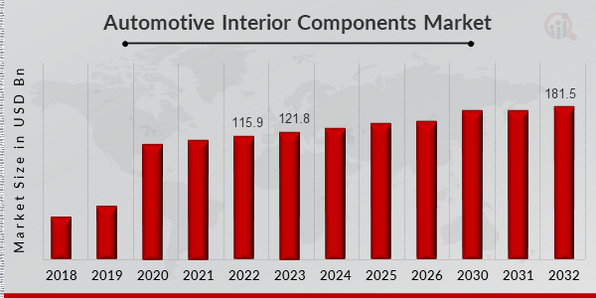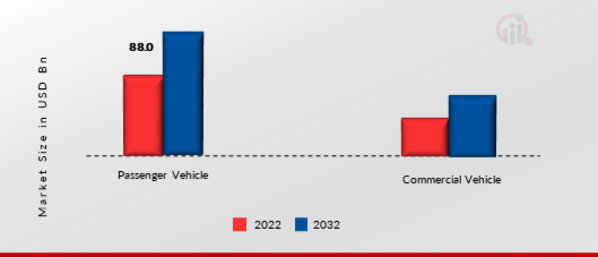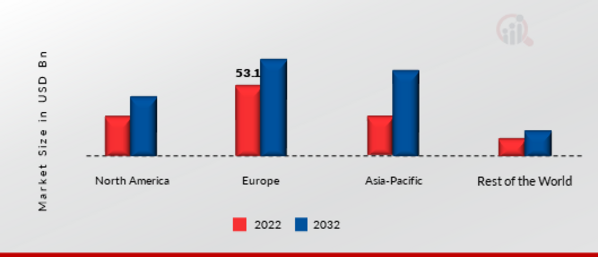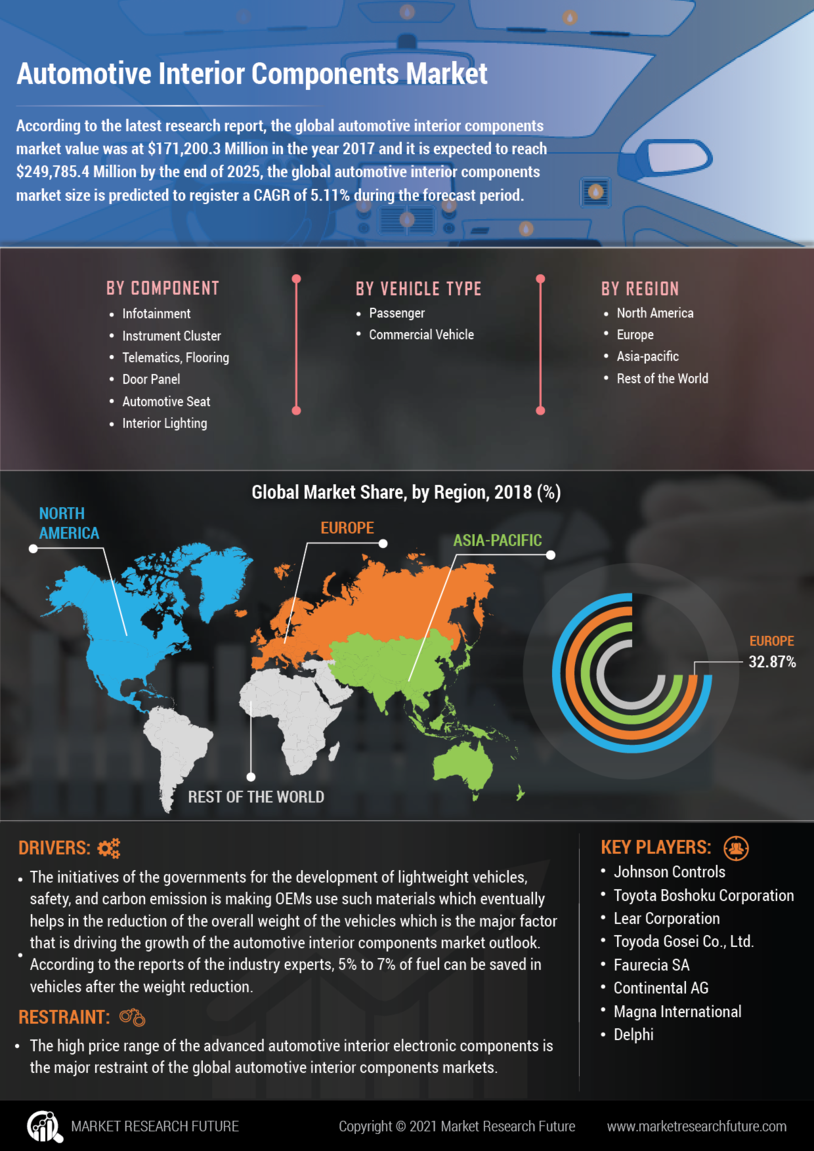Automotive Interior Components Market Overview:
The Automotive Interior Components Market industry is projected to grow from USD 128.04 Billion in 2024 to USD 181.50 Billion by 2032, exhibiting a compound annual growth rate (CAGR) of 4.45% during the forecast period (2024 - 2032). Automotive Interior Components Market Size was valued at USD 121.82 Billion in 2023. Growing Veganism and adopting bioplastics are the key market drivers enhancing the market growth.

Source: Secondary Research, Primary Research, MRFR Database and Analyst Review
Automotive Interior Components Market Trends
-
Growing Veganism is driving the market growth
Market CAGR for automotive interior components is driven by the rising One of the most crucial elements that appeals to and draw a customer's attention to a car is its interior. Therefore, careful material selection is essential for creating appealing automotive interiors. The interior of automobiles is made from a wide range of materials for comfort, including plastics, composites, wood, fabrics, rubber, and numerous others.
Furthermore, these materials must adhere to several industry standards, such as those governing materials used inside buildings. Limits on the flammability of automotive interior materials vary by nation. GB-Standard 8410-2006, for instance, is a Chinese standard that outlines the specifications for CCC-Certification (China Compulsory Certificate) of automotive interior materials to be used in the Chinese market. More than 25% of vehicle fires, according to the National Fire Protection Association in the USA, start in the interior, so it's important to choose the right materials for the interior of cars so that passengers are both comfortable and safe. Since plastics have several advantages, such as reduced weight, flexibility, and design, the automotive industry has long used them for various applications, including interior, exterior, under the hood, and others. The use of plastics made from fossil fuels is becoming less common, so the industry is switching to bio-based plastics to maintain the lightweight and high performance of cars. For instance, the Lexus HS 250h's interior is made of bioplastics. Since plastics have several advantages, such as reduced weight, flexibility, and design, the automotive industry has long used them for various applications, including interior, exterior, under the hood, and others. The use of plastics made from fossil fuels is becoming less common, so the industry is switching to bio-based plastics to maintain the lightweight and high performance of cars. For instance, the Lexus HS 250h's interior is made of bioplastics. Major automakers, including bio-polyesters, bio-PET (polyethylene terephthalate), and PLA-blends (polylactic acid), have adopted several bio-based plastics, including Toyota, for use in various interior components. Headliners, sun visors, floor mats, and several other components in the Toyota Prius and Toyota SAI models are bio-plastics.
The term veganism has also been adopted in the automotive industry. Given the growing demand, automakers now provide their customers with vegan interior leather. For instance, in 2019, at the Shanghai Motor Show, the German automaker Volkswagen unveiled its full-size electric car, the "ID Roomzz," which has interiors made of apple leather. Similarly, other automakers have also revealed upcoming initiatives featuring vegan interiors, including Volvo and Audi. Thus, driving the automotive interior components market revenue.
Automotive Interior Components Market Segment Insights:
Automotive Interior Components Components Insights
The Automotive Interior Components Market segmentation, based on components, includes infotainment, instrument cluster, telematics, flooring, door panel, automotive seat and interior lighting. The door panel segment dominated the market because these materials are simple to process and use. The average amount of plastic used in interior trim in a typical car is about 40% of the total plastic used. Additionally, the door panel and trims make up a sizable portion of the interior of automobiles, providing manufacturers with many customization options and significant weight savings over other parts. These applications use a variety of materials, such as polyethylene terephthalate (PET), polyoxymethylene (POM), polyvinyl chloride (PVC), and ABS (acrylonitrile butadiene styrene), among others. The fastest-growing market is automotive carpets and headliners, which are frequently customized by customers to meet their needs.
Automotive Interior Components Vehicle Type Insights
The Automotive Interior Components Market segmentation, based on vehicle type, includes passenger vehicle and commercial vehicle. The passenger vehicle category generated the most income. The number of passenger cars is rising because of rising populations, more disposable income, and urbanization. Manufacturers typically create more effective braking systems to add more safety features. The primary market share and growth of the passenger car are primarily influenced by the ADAS. Due to an increase in the demand for electromagnetic induction braking systems in cars, motorcycles, and other vehicles over the forecast period, rising ADAS spending is also anticipated to impact the brake systems market.
Figure 1: Automotive Interior Components Market by Vehicle Type, 2022 & 2032 (USD Billion)

Source: Secondary Research, Primary Research, MRFR Database and Analyst Review
Automotive Interior Components Regional Insights
By region, the study provides market insights into North America, Europe, Asia-Pacific and Rest of the World. The European automotive interior components market will dominate this market; due to the growing e-vehicle market, Europe has positioned itself as the second-largest market and is predicted to experience moderate growth. Major nations like Germany, the United Kingdom, Spain, and Italy saw negative growth in the automotive sector.
Further, the major countries studied in the market report are The US, Canada, German, France, the UK, Italy, Spain, China, Japan, India, Australia, South Korea, and Brazil.
Figure 2: Automotive Interior Components Market Share By Region 2022 (USD Billion)

Source: Secondary Research, Primary Research, MRFR Database and Analyst Review
The North American automotive interior components market accounts for the second-largest market share. Due to the steadily expanding automotive industry in the continent, North America is also anticipated to experience moderate growth. In the coming years, market growth will probably be boosted by the region's increasing adoption of electric vehicles. Further, the U.S. automotive interior components market held the largest market share, and the CANADA automotive interior components market was the fastest-growing market in the North American region.
The Asia-Pacific Automotive, Interior Components Market, is expected to grow at the fastest CAGR from 2023 to 2032. fueled by robust automotive industries in China, India, South Korea, Japan, and Thailand. In addition, the region is expected to expand quickly over the forecast period due to the quick rise of the middle class in developing nations like India, China, Taiwan, Thailand, and others. Additionally, the growing use and sales of electric vehicles in the area are anticipated to spur market expansion in the near future. Moreover, China’s automotive interior components market held the largest market share, and the Indian automotive interior components market was the fastest-growing market in the Asia-Pacific region.
Automotive Interior Components Key Market Players & Competitive Insights
Leading market players are investing heavily in research and development in order to expand their product lines, which will help the automotive interior components market grow even more. Market participants are also undertaking various strategic activities to expand their global footprint, with important market developments including new product launches, contractual agreements, mergers and acquisitions, higher investments, and collaboration with other organizations. The automotive interior components industry must offer cost-effective items to expand and survive in a more competitive and rising market climate.
Manufacturing locally to minimize operational costs is one of the key business tactics manufacturers use in the global automotive interior components industry to benefit clients and increase the market sector. The automotive interior components industry has offered some of the most significant advantages in recent years. Major players in the automotive interior components market, including Johnson Controls, Toyota Boshoku Corporation, Lear Corporation, Toyoda Gosei Co., Ltd., Faurecia SA, Continental AG, Magna International, Delphi and others, are attempting to increase market demand by investing in research and development operations.
Delphi, with a global network of over 2750 service centers and a presence in more than 150 countries, Delphi Technologies aftermarket offers OE specification end-to-end solutions, from components to sophisticated software solutions. Delphi Technologies equips mechanics to service and repair cars correctly for the first time with a broad portfolio that includes gasoline fuel systems, diesel fuel systems, maintenance solutions, engine management, and vehicle electronics. This portfolio is supported by OE-level diagnostic and test tools, training, and technical information. BorgWarner Inc. owns the trademark Delphi Technologies. Its product line includes diesel fuel systems, gasoline fuel systems, maintenance solutions, engine management, vehicle electronics, training, diagnostic tools, and test gear.
Lear Corporation has more than 100 years of experience, and while securing its future on innovation, it has established a legacy of operational excellence. Its talented team is dedicated to producing goods that guarantee consumers' safety, comfort, and well-being. It is improving every drive by cooperating. As it lead the organization toward the future of mobility with an unwavering commitment to profitable growth, maintaining a strong culture, and generating value for shareholders, leaders bring to the table unmatched experience.
Key Companies in the automotive interior components market include
- Johnson Controls
- Toyota Boshoku Corporation
- Lear Corporation
- Toyoda Gosei Co., Ltd.
- Faurecia SA
- Continental AG
- Magna International
- Delphi
Automotive Interior Components Industry Developments
Kia has declared that it will rebrand itself as "Platform Beyond Vehicle" in December 2023 and commence operations of its worldwide PBV enterprise at CES 2024 in Las Vegas, United States of America. Several PBV concept models will be tangibly displayed in addition to the brand's forthcoming PBV product lineup and business vision announcement. The 'Total Mobility Solution' offered by Kia PBV combines purpose-built electric vehicles with cutting-edge software solutions to pave the way for new businesses and lifestyles. A series of keynote speakers will elaborate on the brand's future PBV business strategies and vision for the future, including digital solutions developed using the advanced software capabilities of the Hyundai Motor Group, dedicated hardware such as Easy Swap and Dynamic Hybrid modularization technologies, and plans for global partnership integration. This will be the first time the brand has attended the CES in five years. A variety of Kia-exclusive PBV technologies, five concept models (including the first PBV slated for mass production in 2025), and a PBV-dedicated presentation and demonstration that emphasizes the organization's software-defined vehicle strategy and partnership integration plans will be on display at the Kia PBV exhibition.
Citroen India plans to augment its lineup in November 2023 by introducing the C3X crossover. While no official declarations have been issued, it is anticipated that the new automobile will be available for purchase in early 2024. On multiple occasions, the C3X crossover has been observed conducting road tests in India. Recent sightings of it evaluating its roadworthiness on local roads have provided us with an interior look. Spy images indicate that the forthcoming Citroen C3X may share interior components with its siblings, the C3 and the C3 Aircross. The spy photos indicate that the vehicle's interior will be identical to that of the C3. It will feature a 3-spoke multifunction steering wheel, a digital driver's display, and a 10-inch infotainment system with Apple CarPlay and Android Auto. Additionally, the dashboard will feature vertical AC vents on both ends. Notably, these observations are predicated on surveillance photographs, and the automaker has thus far refrained from releasing any information regarding the new vehicle.
Automotive Interior Components Market Segmentation:
Automotive Interior Components Components Outlook
- Infotainment
- Instrument Cluster
- Telematics
- Flooring
- Door Panel
- Automotive Seat
- Interior Lighting
Automotive Interior Components Vehicle Type Outlook
- Passenger Vehicle
- Commercial Vehicle
Automotive Interior Components Regional Outlook
- North America
- Europe
- Germany
- France
- UK
- Italy
- Spain
- Rest of Europe
- Asia-Pacific
- China
- Japan
- India
- Australia
- South Korea
- Australia
- Rest of Asia-Pacific
- Rest of the World
- Middle East
- Africa
- Latin America
| Report Attribute/Metric |
Details |
| Market Size 2023 |
USD 121.82 Billion |
| Market Size 2024 |
USD 128.04 Billion |
| Market Size 2032 |
USD 181.50 Billion |
| Compound Annual Growth Rate (CAGR) |
4.45% (2024-2032) |
| Base Year |
2023 |
| Market Forecast Period |
2023-2032 |
| Historical Data |
2018- 2022 |
| Market Forecast Units |
Value (USD Billion) |
| Report Coverage |
Revenue Forecast, Market Competitive Landscape, Growth Factors, and Trends |
| Segments Covered |
Components, Vehicle Type and Region |
| Geographies Covered |
North America, Europe, Asia Pacific, and the Rest of the World |
| Countries Covered |
The US, Canada, German, France, UK, Italy, Spain, China, Japan, India, Australia, South Korea, and Brazil |
| Key Companies Profiled |
Johnson Controls, Toyota Boshoku Corporation, Lear Corporation, Toyoda Gosei Co., Ltd., Faurecia SA, Continental AG, Magna International, Delphi |
| Key Market Opportunities |
Growing Veganism is driving the market |
| Key Market Dynamics |
The adoption of bioplastics |
Frequently Asked Questions (FAQ) :
The Automotive Interior Components Market size was valued at USD 121.822 Billion in 2023.
The global market is projected to grow at a CAGR of 4.45% during the forecast period, 2024-2032.
Europe had the largest share of the global market
The key players in the market are Johnson Controls, Toyota Boshoku Corporation, Lear Corporation, Toyoda Gosei Co., Ltd., Faurecia SA, Continental AG, Magna International, and Delphi.
The door panel category dominated the market in 2023.
The passenger vehicle had the largest share in the global market.



























